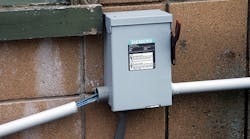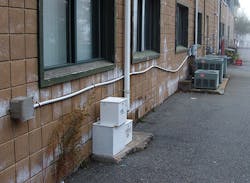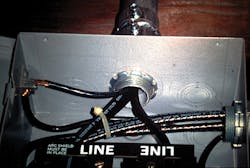Illustrated Catastrophes: PVC Thermal Expansion/Contraction and Protective Bushings
All references are based on the 2014 edition of the NEC.
No Room to Grow
As indicated by these two photos, when PVC thermal expansion and contraction is not taken into consideration when designing and installing PVC conduit runs, the pipe run can simply self-destruct. Section 300.7(B) requires expansion fittings to be used on raceways “where necessary to compensate for thermal expansion and contraction.” Section 352.44 more specifically requires expansion fittings to be used for PVC conduit where the length change for a straight run between securely mounted items is expected to be ¼ in. or greater, in accordance with Table 352.44.
The pipe run in the photo is approximately 30 ft long. If we assume a temperature change from 95°F in the summer to about 5°F in the winter — which happens on a regular basis where I live in New England — then there is a temperature change of 90°F. According to Table 352.44, a 100-ft run would experience a length change of about 3.65 in. Therefore, this 30-ft pipe run would experience a length change of approximately
1 in. If an expansion fitting is not used, this length change will cause more than enough strain and pressure on the couplings, clips, and connectors to cause distortion and breakage. That is exactly what happened to this installation.
This Service Got Ambushed
This job was ambushed by the lack of bushings. Section 300.4 requires insulated conductors sized 4 AWG and larger to be protected by a fitting, such as a plastic bushing, when installed in raceways such as this EMT. Protective bushings are not required for raceways threaded into enclosures where the threaded hubs or bosses provide a smooth rounded edge. The service raceway entering the top of the disconnect is also lacking a bonding bushing as required by 250.92(B). Standard locknuts are not permitted as the only bonding means for bonding a service raceway to an enclosure containing service conductors. Bonding jumpers must be used to bond around “impaired connections,” such as the remaining knockout rings. If a ground fault occurred on the service conductors — and the fault current passed through the small bits of metal connecting the rings together — the rings could simply be blown apart by the high fault current, which could then cause an arc and a fire. The foot lug for the bonding jumper attached to the side of the enclosure was attached to the enclosure with a sheet metal screw. Using sheet metal screws is not one of the methods permitted in Sec. 250.8.







